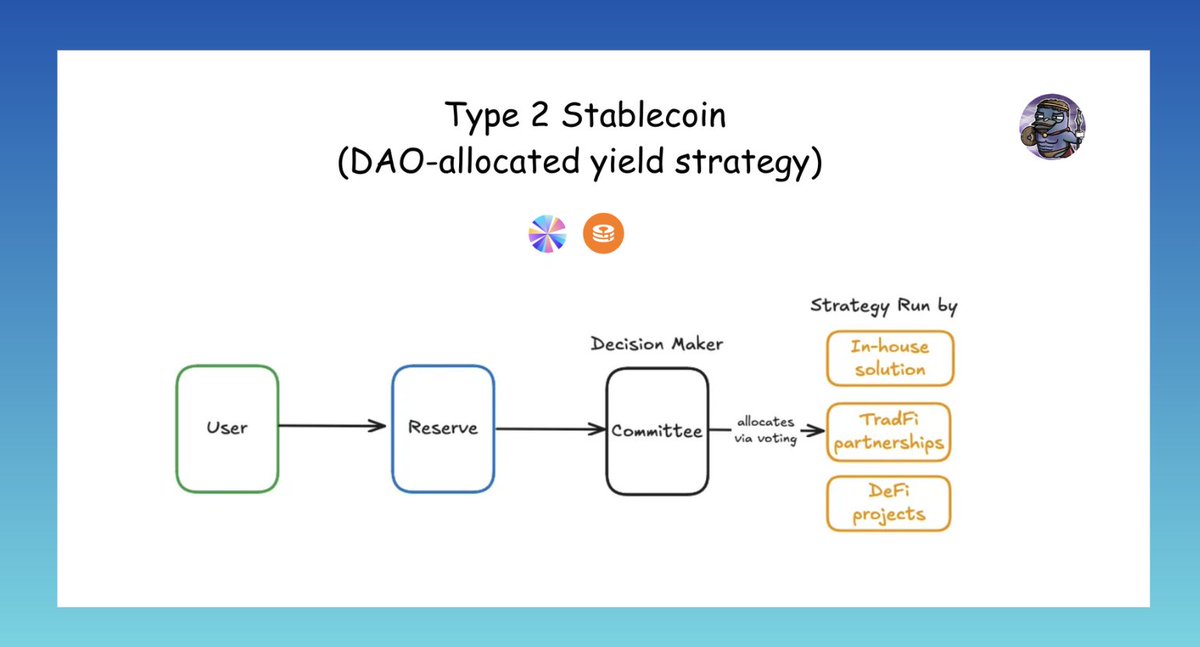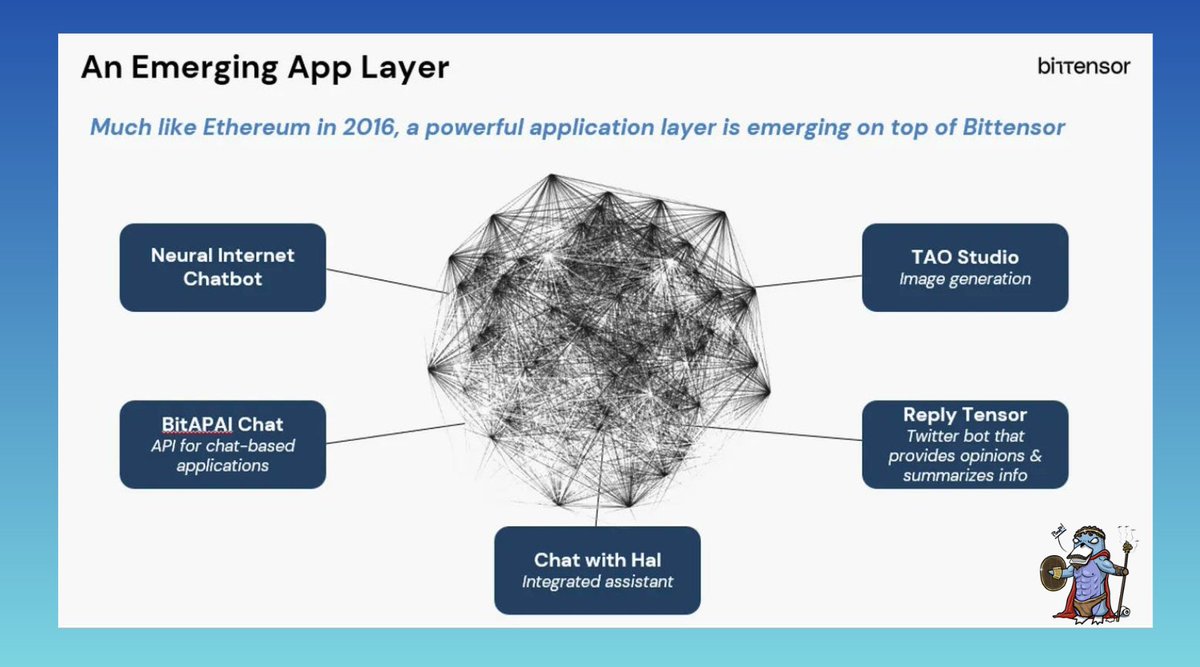Insightful read about Type-3 stablecoin proposed by @capmoney_ , one of the coolest design I have seen in a while and I want to simplify a bit.
In yield generating stablecoin today, we have 2 major types:
Type 1: Tokenised hedge fund
Type 2: DAO-allocated yield strategy
🧵
In yield generating stablecoin today, we have 2 major types:
Type 1: Tokenised hedge fund
Type 2: DAO-allocated yield strategy
🧵

1/
Type 1 Stable:
(Tokenised hedge fund)
Marketplace where project utilise user's deposits to generate yield while the team gets the final say over the model and resource allocation.
This design is the most common because it's relatively simple to launch by focusing on one or few strategies.
But the trade off is that no strategy can sustain above-market yields forever and therefore losing TVL to certain strategy depending on market condition.
Example:
@ethena_labs
@ResolvLabs
@OndoFinance
@levelusd
@usualmoney
Type 1 Stable:
(Tokenised hedge fund)
Marketplace where project utilise user's deposits to generate yield while the team gets the final say over the model and resource allocation.
This design is the most common because it's relatively simple to launch by focusing on one or few strategies.
But the trade off is that no strategy can sustain above-market yields forever and therefore losing TVL to certain strategy depending on market condition.
Example:
@ethena_labs
@ResolvLabs
@OndoFinance
@levelusd
@usualmoney

2/
Type 2 Stable :
(DAO-allocated yield strategy)
A DAO / committee that can delegate user deposits to get expose for various yield strategies.
Committee are the decision maker instead of the project, and token holders can delegate their token (aka voting power) to professional delegates such as @EntropyAdvisors / @Blockworks_ / @SteakhouseFi to maximise protocol return.
The tradeoff would be group corruption (Bribing is common in DAO-driven structure) and the lack of efficiency due to the stage of processing.
Example:
@SkyEcosystem
@maplefinance
Type 2 Stable :
(DAO-allocated yield strategy)
A DAO / committee that can delegate user deposits to get expose for various yield strategies.
Committee are the decision maker instead of the project, and token holders can delegate their token (aka voting power) to professional delegates such as @EntropyAdvisors / @Blockworks_ / @SteakhouseFi to maximise protocol return.
The tradeoff would be group corruption (Bribing is common in DAO-driven structure) and the lack of efficiency due to the stage of processing.
Example:
@SkyEcosystem
@maplefinance

3/
Type 3 Stable:
(Self enforcing / market based yield strategy)
Capital is allocated autonomously based on the performance of various yield strategies in different market conditions, and yield is "guaranteed" by sharing the risk with restakers.
In short, there are 3 major parties in type 3 stable:
- Operators
- Restakers
- Depositors (Users)
Operators are institutions tasked with generating yield, where restakers can delegate their assets to the operators to provide "guarantees" and trust in return for yield. User deposits are then utilized and deployed into different strategies according to market dynamics.
Yield is the "Sum of the deposit rate at major lending markets, plus the added utilization premium at the protocol" (Now only @capmoney_ is doing). Any yield falling below the benchmark for too long will either be slashed or dropped from the protocol.
While this design minimizes human decision intervention, complexity in algo design and much like Type 1 stable, the role of token utility remain tricky questions as governance power is given to market to design.
Competition from Type 1 stable startegy during peak bull markets is also a concern that both Type 2 and Type 3 stablecoins face.
@capmoney_ is the only one that doing it and pioneering and I would say they are one of the best / coolest stable design i have seen in a while.
Type 3 Stable:
(Self enforcing / market based yield strategy)
Capital is allocated autonomously based on the performance of various yield strategies in different market conditions, and yield is "guaranteed" by sharing the risk with restakers.
In short, there are 3 major parties in type 3 stable:
- Operators
- Restakers
- Depositors (Users)
Operators are institutions tasked with generating yield, where restakers can delegate their assets to the operators to provide "guarantees" and trust in return for yield. User deposits are then utilized and deployed into different strategies according to market dynamics.
Yield is the "Sum of the deposit rate at major lending markets, plus the added utilization premium at the protocol" (Now only @capmoney_ is doing). Any yield falling below the benchmark for too long will either be slashed or dropped from the protocol.
While this design minimizes human decision intervention, complexity in algo design and much like Type 1 stable, the role of token utility remain tricky questions as governance power is given to market to design.
Competition from Type 1 stable startegy during peak bull markets is also a concern that both Type 2 and Type 3 stablecoins face.
@capmoney_ is the only one that doing it and pioneering and I would say they are one of the best / coolest stable design i have seen in a while.

If you are interested to dig deeper, here is the portal:
x.com/capmoney_/stat…
Just wanna tag my stablecoin fds for the great read, sharing is caring.
@DeFiDave22
@Degenerate_DeFi
@Piotr_Saczuk
@Dynamo_Patrick
@Route2FI
@DefiIgnas
@0xASK
@hmalviya9
@0xBreadguy
@phtevenstrong
@the_smart_ape
@consensus128
@Nick_van_Eck
@howdymerry
@crypto_linn
x.com/capmoney_/stat…
Just wanna tag my stablecoin fds for the great read, sharing is caring.
@DeFiDave22
@Degenerate_DeFi
@Piotr_Saczuk
@Dynamo_Patrick
@Route2FI
@DefiIgnas
@0xASK
@hmalviya9
@0xBreadguy
@phtevenstrong
@the_smart_ape
@consensus128
@Nick_van_Eck
@howdymerry
@crypto_linn
• • •
Missing some Tweet in this thread? You can try to
force a refresh















